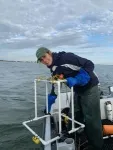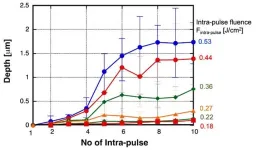(Press-News.org) In the campaign to restore Chesapeake Bay, oyster sanctuaries rank among the most hotly contested strategies. But new research suggests these no-harvest areas are working, and not only for the oysters. In a new study published July 4 in Marine Ecology Progress Series, Smithsonian biologists discovered oyster sanctuaries contain more abundant populations of oysters and other animal life—and the presence of two common parasites is not preventing that.
Oysters form the backbone of Chesapeake Bay. Besides injecting millions of dollars into the regional economy each year, they also act as vital habitat and filter feeders that clean the water. But their populations have dwindled to roughly 1% of historic levels. Disease, overharvesting, habitat loss and pollution have all whittled down their numbers.
Over the past two decades, Maryland and Virginia have worked to restore their oysters by creating vast networks of sanctuaries where oysters are protected from harvest. This has led to a rebound of oyster growth, habitat quality and biodiversity within the sanctuaries, the new study reported.
“The sanctuary programs appear to be working and facilitating oyster reef regrowth after so many decades of overharvesting,” said lead author Zofia Anchondo, who did the research as part of her graduate fellowship with the Smithsonian Environmental Research Center and the University of North Carolina at Chapel Hill.
But at the same time, the resurgence in marine life went hand in hand with a rise in oyster parasites. The study looked at two parasites in particular: the boring sponge and the mud blister worm. Boring sponges drill holes through oyster shells to find shelter. Blister worms form U-shaped burrows inside the shells. The presence of either can render oysters unsightly or even unmarketable. Both are considered likely native to the bay, and neither are harmful to people. For this study, the researchers did not look at dermo or MSX, two non-native parasites responsible for some of the worst oyster crashes, though they collected data for a follow-up study.
Parasitism is the most common lifestyle on Earth, so a parasite’s presence is not necessarily a sign that the environment is out of joint, the authors pointed out.
"Parasites have been ignored as an important component of biodiversity,” said Allison Tracy, a co-author from the University of Maryland, Baltimore County and the University of Maryland School of Medicine. “But they’re a natural part of ecosystems….The way ecosystems naturally function depends on parasite effects.”
“They’re not preventing high oyster densities,” said Matt Ogburn, a co-author and senior scientist with the Smithsonian Environmental Research Center. They may even be good for the oysters’ long-term evolution, Ogburn added, though that question needs more definitive research. “Restoring the oyster reefs is likely to be helping the oyster population become more resilient to the parasites that are out there now, compared to what would be possible if everything was harvested all the time.”
The new study focused on three Chesapeake tributaries: the Choptank River, the Great Wicomico River and the James River. Each had its own oyster sanctuary and another harvest area for comparison, where watermen and -women could freely catch oysters. The scientists used footage from underwater GoPro cameras to give each reef a habitat “score” (one through four, based on the percentage of oyster cover and vertical structure). The GoPro videos also enabled them to record other animals visiting the oyster reefs. Working under state research permits, divers later collected some of the oysters from each reef to estimate oyster density and search for parasites.
Overall, oysters fared better in the sanctuaries. All three tributaries had higher densities of legal, harvest-sized oysters in their sanctuaries than in their harvest sites. In two tributaries—the James and Great Wicomico rivers—oysters of all sizes, including juveniles and baby oysters, were more abundant in the sanctuaries.
Sanctuaries also scored higher for habitat quality, and the videos captured plenty of underwater animals taking advantage of them. Blue crabs, rockfish and summer flounder were just a few of the species that flocked to the sanctuary reefs. In the James and Great Wicomico rivers, the researchers estimated sanctuaries hosted 10 times as many animals, and nearly double the number of species, as the harvest reefs. The one exception was the Choptank River, where animal life was low in both the sanctuary and harvest sites.
Yet as the oysters flourished, so did the two parasites. More than half the oysters in all six sites—sanctuary and harvest—had the telltale holes of a boring sponge attack. However, the boring sponge was more prevalent in sanctuaries than harvest sites within two of the three tributaries. Mud blister worms were far less abundant—infecting 2–10% of oysters—but still higher in sanctuaries than harvest sites for two of the tributaries.
Neither parasite, the authors pointed out, is dangerous to humans. Both parasites only infect oyster shells, not the oyster tissue that people eat.
“It’s more of a concern for the fishery, because they can make the shells less attractive,” Tracy said. “It can decrease the value of the oyster for the half-shell market. But they have no effect on our health.” In the unlikely event that a person did accidentally slurp up one of these parasites with their raw oyster, Tracy said, it would simply pass through their system without impact. “There’s no shell that it can find to bore into in your stomach. So basically, it would be uninterested.”
The study is available at https://www.int-res.com/abstracts/meps/v739/p65-83/. For photos or to speak with one of the authors, contact Kristen Goodhue at goodhuek@si.edu.
END
Restored oyster sanctuaries host more marine life
Sanctuaries in Chesapeake shelter higher oyster populations and more marine life—including parasites—than nearby harvest areas
2024-07-08
ELSE PRESS RELEASES FROM THIS DATE:
Research spotlight: Machine learning helps identify patients at varying levels of risk for opioid use disorder
2024-07-08
Ronen Rozenblum, PhD, MPH, director of the Unit for Innovative Healthcare Practice & Technology and director of Business Development of the Center for Patient Safety Research and Practice at Brigham and Women's Hospital, and an assistant professor at Harvard Medical School, is the principal investigator and senior author of a new study published in JMIR Medical Informatics, “A Machine Learning Application to Classify Patients at Differing Levels of Risk of Opioid Use Disorder: Clinician Based ...
Detroit researchers receive Department of Defense grant to assist in discovering new treatments for ovarian cancer
2024-07-08
DETROIT — Gen Sheng Wu, Ph.D., professor of oncology in the Wayne State University School of Medicine and the Barbara Ann Karmanos Cancer Institute, recently received a grant from the U.S. Department of Defense’s Congressionally Directed Medical Research Programs.
This four-year, $924,000 grant will benefit Wu’s study, “Targeting Dual-Specificity Phosphatase 1 in Platinum Resistance in Ovarian Cancer,” which aims to discover improved treatments for ovarian cancer.
“Ovarian cancer ...
Acupuncture reduces methadone dose and opioid cravings in patients undergoing methadone maintenance therapy
2024-07-08
Embargoed for release until 5:00 p.m. ET on Monday 8 July 2024
Annals of Internal Medicine Tip Sheet
@Annalsofim
Below please find summaries of new articles that will be published in the next issue of Annals of Internal Medicine. The summaries are not intended to substitute for the full articles as a source of information. This information is under strict embargo and by taking it into possession, media representatives are committing to the terms of ...
Novel compound offers improved defense against fentanyl overdoses
2024-07-08
Scientists at the University of Florida have identified a novel compound aimed at improving the treatment of opioid overdoses, which claimed the lives of more than 81,000 Americans last year.
The discovery could combat the devastating epidemic of opioid-related deaths, driven predominantly by the proliferation of fentanyl. The highly potent synthetic opioid is a pain reliever and among the nation’s most abused substances.
“Fentanyl is driving the need to find better treatments for opioid overdoses,” said Jay McLaughlin, Ph.D., a professor of pharmacodynamics in the UF College of Pharmacy. “Every opioid death is preventable, highlighting ...
NIH awards Wake Forest University School of Medicine $27 million to study vascular health and its impact on cognition
2024-07-08
WINSTON-SALEM, N.C. – July 8, 2024 – Researchers at Wake Forest University School of Medicine have been awarded a five-year, $27 million grant from the National Institute on Aging (NIA), part of the National Institutes of Health (NIH), to renew funding for MESA-MIND, an ancillary study to the Multi-Ethnic Study of Atherosclerosis (MESA).
In 2018, researchers at Wake Forest University School of Medicine received more than $18 million from the NIA to launch MESA-MIND to study the connections between heart health and brain health.
“In MESA-MIND, we are studying how heart health contributes to brain health in diverse groups of people,” said Timothy Hughes, Ph.D., ...
College of Public Health receives NIH grant to pilot AI chatbot for African Americans with depression
2024-07-08
As a leader in innovative health solutions, George Mason University’s College of Public Health received a National Institutes of Health (NIH) AIM-AHEAD program grant to pilot an artificial intelligence (AI) chatbot for Black and African Americans with depression. Health Informatics Professor Farrokh Alemi will enhance his first-of-its-kind, evidence-based artificial intelligence tool to address the medication needs of African Americans with depression.
The existing AI tool recommends antidepressants for 16,775 general-population patient subgroups, each representing a unique combination of medical history. For each of ...
RCMAR Annual Meeting promotes mentorship and research on aging
2024-07-08
The latest Annual Meeting convened by the Resource Centers for Minority Aging Research (RCMAR) National Coordinating Center, held in Arlington, Virginia, from June 26 to 28, centered on the theme of transforming diverse aging research through inspiring and mentoring scientists.
Current and former RCMAR scientists presented research findings from completed pilot studies and progress updates for ongoing research. The meeting included several professional development sessions for the scientists and members of RCMAR ...
Exploring distress experiences of patients with sickle cell disease
2024-07-08
COLUMBUS, Ohio – While distress is well-documented in patients with sickle cell disease, sources of distress and how patients manage distress have not been well explored.
“Our study found that the most profound source of distress for patient with sickle cell disease in a home visit program was anticipating and going to acute care centers to manage their acute pain,” said senior study author Maryanna Klatt, PhD, director of the Center for Integrative Health at The Ohio State University Wexner Medical Center.
Study findings are published ...
Super-resolution machining of single crystalline sapphire by GHz burst mode femtosecond laser-induced plasma assisted ablation
2024-07-08
A new publication from Opto-Electronic Advances; DOI 10.29026/oea.2024.240029 , discusses super-resolution machining of single crystalline sapphire by GHz burst mode femtosecond laser-induced plasma assisted ablation.
GHz burst-mode femtosecond (fs) laser, which emits a series of pulse trains (burst pulse) with extremely short intervals of several hundred ps, offers distinct characteristics in materials processing as compared with conventional fs laser (single-pulse mode). The authors of this article have demonstrated that the GHz burst mode fs laser greatly improves ablation efficiency, quality and speed. GHz burst mode fs laser was further applied ...
Boosting UV light absorption in 2D semiconductor with quantum dot hybrids for enhanced light emission
2024-07-08
A new publication from Opto-Electronic Advances; DOI 10.29026/oes.2024.240002 , discusses boosting UV Light Absorption in 2D Semiconductor with quantum dot hybrids for enhanced light emission.
Two-dimensional (2D) transition metal dichalcogenides (TMDs) have emerged as a promising class of materials due to their remarkable properties. These materials, such as monolayer tungsten disulfide (1L-WS2), are just a few atoms thick, yet they possess intriguing electronic and optical characteristics that make them highly attractive for various applications, from flexible electronics ...
LAST 30 PRESS RELEASES:
First Editorial of 2026: Resisting AI slop
Joint ground- and space-based observations reveal Saturn-mass rogue planet
Inheritable genetic variant offers protection against blood cancer risk and progression
Pigs settled Pacific islands alongside early human voyagers
A Coral reef’s daily pulse reshapes microbes in surrounding waters
EAST Tokamak experiments exceed plasma density limit, offering new approach to fusion ignition
Groundbreaking discovery reveals Africa’s oldest cremation pyre and complex ritual practices
First breathing ‘lung-on-chip’ developed using genetically identical cells
How people moved pigs across the Pacific
Interaction of climate change and human activity and its impact on plant diversity in Qinghai-Tibet plateau
From addressing uncertainty to national strategy: an interpretation of Professor Lim Siong Guan’s views
Clinical trials on AI language model use in digestive healthcare
Scientists improve robotic visual–inertial trajectory localization accuracy using cross-modal interaction and selection techniques
Correlation between cancer cachexia and immune-related adverse events in HCC
Human adipose tissue: a new source for functional organoids
Metro lines double as freight highways during off-peak hours, Beijing study shows
Biomedical functions and applications of nanomaterials in tumor diagnosis and treatment: perspectives from ophthalmic oncology
3D imaging unveils how passivation improves perovskite solar cell performance
Enriching framework Al sites in 8-membered rings of Cu-SSZ-39 zeolite to enhance low-temperature ammonia selective catalytic reduction performance
AI-powered RNA drug development: a new frontier in therapeutics
Decoupling the HOR enhancement on PtRu: Dynamically matching interfacial water to reaction coordinates
Sulfur isn’t poisonous when it synergistically acts with phosphine in olefins hydroformylation
URI researchers uncover molecular mechanisms behind speciation in corals
Chitin based carbon aerogel offers a cleaner way to store thermal energy
Tracing hidden sources of nitrate pollution in rapidly changing rural urban landscapes
Viruses on plastic pollution may quietly accelerate the spread of antibiotic resistance
Three UH Rainbow Babies & Children’s faculty elected to prestigious American Pediatric Society
Tunnel resilience models unveiled to aid post-earthquake recovery
Satellite communication systems: the future of 5G/6G connectivity
Space computing power networks: a new frontier for satellite technologies
[Press-News.org] Restored oyster sanctuaries host more marine lifeSanctuaries in Chesapeake shelter higher oyster populations and more marine life—including parasites—than nearby harvest areas






